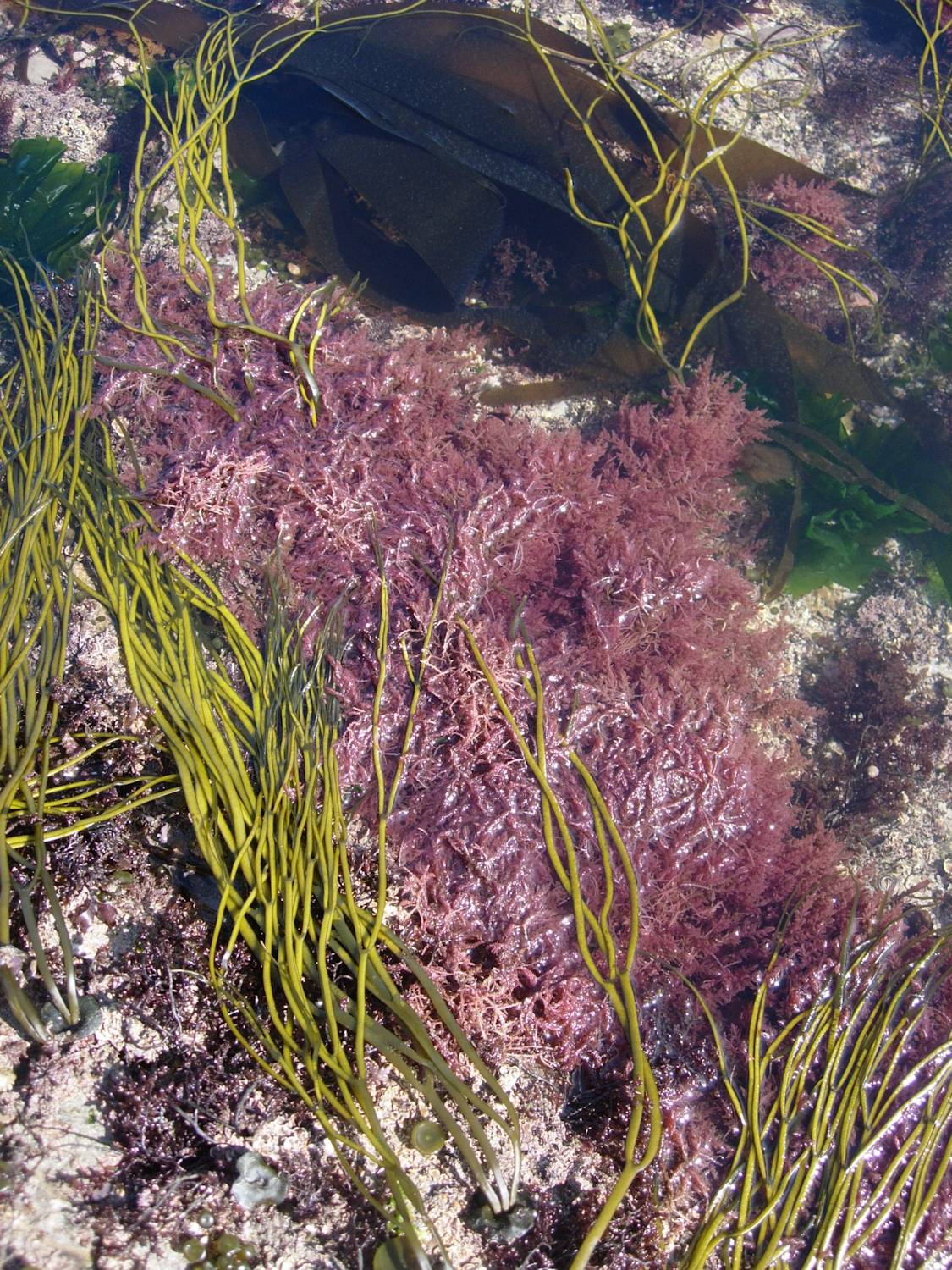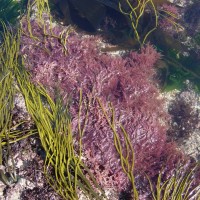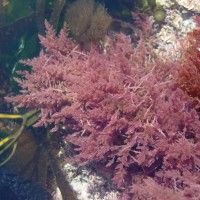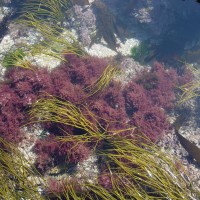
Harpoon weed - Asparagopsis armata
Expand and collapse the sections below by clicking on the title or + / - icons.
Short description of Asparagopsis armata, Harpoon weed
The life cycle of harpoon weed has two morphologically different phases; the sexual (gametophyte) plant is rosy, yellowish pink or whitish pink, erect and spreading, with many feathery branches; up to 30 cm tall with some branches developing as conspicuous harpoon-like barbed structures up to 10 mm long. The asexual (tetrasporophyte) plant is rosy pink, filamentous, and forms fine wooly balls 10 - 20 mm in diameter.
Impact summary: Asparagopsis armata, Harpoon weed
Harpoon weed is reported to dominate algal assemblages in some locations; it forms bloom-like outbreaks and is known to cover 100% of the upper infralittoral (0 – 10 metres depth) during winter in the NW Mediterranean.
Habitat summary: Asparagopsis armata, Harpoon weed
The gametophyte occurs mainly in summer in shallow subtidal waters or in deep tidal pools on the lower shore, attached to various substrates – often to other algae by barbed branchlets. The Falkenbergia stage occurs all year round; it is epiphytic or sometimes free living, typically found subtidally and sometimes tangled up in other seaweeds.
Overview table
| Environment | Marine |
|---|---|
| Species status | Non-Native |
| Native range | Australia, New Zealand |
| Functional type | Algae (macroalgae) |
| Status in England | Non-Native |
| Status in Scotland | Non-Native |
| Status in Wales | Non-Native |
| Location of first record | Lundy |
| Date of first record | 1949 |
Origin
Harpoon weed is endemic to the Southern Hemisphere and thought to originate from Australia and New Zealand.
First Record
The Falkenbergia stage was first recorded in GB in 1949 at Lundy in the Bristol Channel, following its discovery in Galway Bay, Ireland in 1939.
Pathway and Method
Harpoon weed most likely spread to GB from alien populations already established in Europe, by rafting and drifting on surface currents. It may have been introduced to mainland Europe, where it was first recorded in the Bay of Biscay, France, in 1925 with oyster imports. Hull fouling has also been suggested as a possible vector.
Species Status
Harpoon weed has been introduced from its native range to Western Europe, the northern Mediterranean, North Africa, Japan and the west coast of North America during the twentieth century.
Dispersal Mechanisms
The gametophyte stage attaches itself by its hooks to other material including fragments of other seaweeds and is dispersed through drifting or rafting on surface currents. The Falkenbergia phase spreads easily as floating balls. The two stages are thought to be spreading independently by vegetative means (clonal reproduction).
Reproduction
Both stages reproduce vegetatively, i.e. they are able to reproduce by cloning, and the sexes are separate. The Falkenbergia stage produces haploid spores that develop into male or female free-living gametophytes. The large barbed growths of the plant are the sexual gametophytes. Fertilization occurs on the female reproductive structures, giving rise to a diploid zygote that develops into a multicellular structure called a carposporophyte (a pustule-like structure). The carposporophyte eventually produces and releases diploid carpospores that develop into tetrasporophytes (the Falkenbergia stage).
Known Predators/Herbivores
Harpoon weed is unpalatable to most herbivores due to chemical defences, but is known to be consumed by the sea hare Aplysia parvula and black-lip abalone Haliotis rubra in its native Australia.
Resistant Stages
None known.
Habitat Occupied in GB
The gametophyte occurs in shallow subtidal waters or deep pools on the lower shore, attached to a variety of substrates including rock, and sometimes attaches to other seaweeds by its barbed branchlets. The Falkenbergia stage is typically found subtidally; it is epiphytic or sometimes free-living. It is also known to grow in abundance amongst eelgrass beds, for example in the Scilly Isles.
Native range from Australia and New Zealand. In GB the gametophyte occurs in the southwest of England, while the Falkenbergia stage occurs north to Shetland but is rare on the east coasts.
Environmental Impact
Harpoon weed is reported to dominate algal assemblages in some locations; it forms bloom-like outbreaks and is known to cover 100% of the upper infralittoral (0 – 10 metres depth) during winter in the NW Mediterranean.
Health and Social Impact
Can cause a minor nuisance by sticking to the clothing of people swimming and snorkelling using its barbs.
Economic Impact
Economic losses to fisheries have been reported due to harpoon weed clogging up fishing nets when it occurs in bloom-like outbreaks. In Ireland, harpoon weed has recently been identified as a commercially important species for the production of cosmetics.
Identification
Bunker, F.StP.D., Maggs, C.A., Brodie, J.A. & Bunker, A.R. (2010) Seasearch Guide to Seaweeds of Britain and Ireland. Marine Conservation Society, Ross-on-Wye.
Skewes, M. (2003) Asparagopsis armata. Harpoon weed. Marine Life Information Network: Biology and Sensitivity Key Information Sub-programme [on-line]. Plymouth: Marine Biological Association of the United Kingdom. Available from: http://www.marlin.ac.uk/speciesinformation.php?speciesID=2643
Biology, ecology, spread, vectors
Andreakis, N., Procaccini, G., Maggs, C. & Kooistras, W.H.C.F. (2007) Phylogeography of the invasive seaweed Asparagopsis (Bonnemaisoniales, Rhodophyta) reveals cryptic diversity. Molecular Ecology, 16, 2285-2299.
Bonin, D.R. & Hawkes, M.W. (1987) Systematics and life histories of New Zealand Bonnemaisoniaceae (Bonnemaisoniales, Rhodophyta): 1. The genus Asparagopsis. New Zealand Journal of Botany, 25, 577-590.
Lobban, C.S. & Wynne, M.J. (Eds) (1981) The biology of seaweeds. Botanical Monographs Volume 17. Blackwell Scientific Publications, Oxford.
Maggs, C.A. & Stegenga, H. (1999) Red algal exotics on North Sea coasts. Helgoland Marine Research, 52, 243-258.
Ní Chualáin, F., Maggs, C.A., Saunders, G.W. & Guiry, M.D. (2004) The invasive genus Asparagopsis (Bonnemaisoniaceae, Rhodophyta): molecular systematics, morphology, and ecophysiology of Falkenbergia isolates. Journal of Phycology, 40, 1112-1126.
Verges, A., Paul, N.A. & Steinberg, P.D. (2008) Sex and life history stage alter herbivore responses to a chemically defended red alga. Ecology, 89, (5), 1334-1343.
Management and impact
Streftaris, N. & Zenetos, A. (2006) Alien Marine Species in the Mediterranean – the 100 ‘Worst Invasives’ and their impact. Mediterranean Marine Science, 7, (1), 87-118.
General
Bunker, F.StP.D., Maggs, C.A., Brodie, J.A. & Bunker, A.R. (2010) Seasearch Guide to Seaweeds of Britain and Ireland. Marine Conservation Society, Ross-on-Wye.
Spotted this species?
Distribution map
View the Distribution map for Harpoon weed, Asparagopsis armata from NBN Atlas
Legislation
Asparagopsis armata is listed under Schedule 9 of the Wildlife and Countryside Act 1981. Read more about Non-native species legislation.



